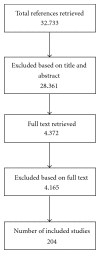Evidence map of prevention and treatment interventions for depression in young people
- PMID: 22496974
- PMCID: PMC3312218
- DOI: 10.1155/2012/820735
Evidence map of prevention and treatment interventions for depression in young people
Abstract
Introduction. Depression in adolescents and young people is associated with reduced social, occupational, and interpersonal functioning, increases in suicide and self-harm behaviours, and problematic substance use. Age-appropriate, evidence-based treatments are required to provide optimal care. Methods. "Evidence mapping" methodology was used to quantify the nature and distribution of the extant high-quality research into the prevention and treatment of depression in young people across psychological, medical, and other treatment domains. Results. Prevention research is dominated by cognitive-behavioral- (CBT-) based interventions. Treatment studies predominantly consist of CBT and SSRI medication trials, with few trials of other psychological interventions or complementary/alternative treatments. Quality studies on relapse prevention and treatment for persistent depression are distinctly lacking. Conclusions. This map demonstrates opportunities for future research to address the numerous evidence gaps for interventions to prevent or treat depression in young people, which are of interest to clinical researchers, policy makers, and funding bodies.
Figures
Similar articles
-
Mapping the evidence for the prevention and treatment of eating disorders in young people.J Eat Disord. 2014 Feb 3;2:5. doi: 10.1186/2050-2974-2-5. eCollection 2014. J Eat Disord. 2014. PMID: 24999427 Free PMC article. Review.
-
Right care, first time: a highly personalised and measurement-based care model to manage youth mental health.Med J Aust. 2019 Nov;211 Suppl 9:S3-S46. doi: 10.5694/mja2.50383. Med J Aust. 2019. PMID: 31679171
-
Screening for Depression, Anxiety, and Suicide Risk in Children and Adolescents: An Evidence Review for the U.S. Preventive Services Task Force [Internet].Rockville (MD): Agency for Healthcare Research and Quality (US); 2022 Oct. Report No.: 22-05293-EF-1. Rockville (MD): Agency for Healthcare Research and Quality (US); 2022 Oct. Report No.: 22-05293-EF-1. PMID: 36282939 Free Books & Documents. Review.
-
Psychological treatments for depression and anxiety in dementia and mild cognitive impairment.Cochrane Database Syst Rev. 2022 Apr 25;4(4):CD009125. doi: 10.1002/14651858.CD009125.pub3. Cochrane Database Syst Rev. 2022. PMID: 35466396 Free PMC article. Review.
-
Nonsomatic treatment of depression.Child Adolesc Psychiatr Clin N Am. 2002 Jul;11(3):579-93. doi: 10.1016/s1056-4993(02)00009-3. Child Adolesc Psychiatr Clin N Am. 2002. PMID: 12222084 Review.
Cited by
-
Effectiveness trial of an indicated cognitive-behavioral group adolescent depression prevention program versus bibliotherapy and brochure control at 1- and 2-year follow-up.J Consult Clin Psychol. 2015 Aug;83(4):736-47. doi: 10.1037/ccp0000022. Epub 2015 Apr 20. J Consult Clin Psychol. 2015. PMID: 25894666 Free PMC article. Clinical Trial.
-
Psychosocial interventions for self-harm, suicidal ideation and suicide attempt in children and young people: What? How? Who? and Where?Evid Based Ment Health. 2017 May;20(2):35-40. doi: 10.1136/eb-2017-102667. Epub 2017 Apr 3. Evid Based Ment Health. 2017. PMID: 28373210 Free PMC article. Review.
-
The Evidence-Base for Psychodynamic Psychotherapy With Children and Adolescents: A Narrative Synthesis.Front Psychol. 2021 Apr 27;12:662671. doi: 10.3389/fpsyg.2021.662671. eCollection 2021. Front Psychol. 2021. PMID: 33986713 Free PMC article.
-
Mental health, well-being and support interventions for UK ambulance services staff: an evidence map, 2000 to 2020.Br Paramed J. 2021 Mar 1;5(4):25-39. doi: 10.29045/14784726.2021.3.5.4.25. Br Paramed J. 2021. PMID: 34421373 Free PMC article.
-
Cognitive behavioural therapy (CBT), third-wave CBT and interpersonal therapy (IPT) based interventions for preventing depression in children and adolescents.Cochrane Database Syst Rev. 2016 Aug 9;2016(8):CD003380. doi: 10.1002/14651858.CD003380.pub4. Cochrane Database Syst Rev. 2016. PMID: 27501438 Free PMC article. Review.
References
-
- J. Costello E, Erkanli A, Angold A. Is there an epidemic of child or adolescent depression? Journal of Child Psychology and Psychiatry. 2006;47(12):1263–1271. - PubMed
-
- Birmaher B, Ryan ND, Williamson DE, et al. Childhood and adolescent depression: a review of the past 10 years. Part I. Journal of the American Academy of Child and Adolescent Psychiatry. 1996;35(11):1427–1439. - PubMed
-
- Lewinsohn PM, Rohde P, Seeley JR. Major depressive disorder in older adolescents: prevalence, risk factors, and clinical implications. Clinical Psychology Review. 1998;18(7):765–794. - PubMed
-
- Gould MS, King R, Greenwald S, et al. Psychopathology associated with suicidal ideation and attempts among children and adolescents. Journal of the American Academy of Child and Adolescent Psychiatry. 1998;37(9):915–923. - PubMed
-
- Weissman MM, Wolk S, Goldstein RB, et al. Depressed adolescents grown up. Journal of the American Medical Association. 1999;281(18):1707–1713. - PubMed
LinkOut - more resources
Full Text Sources





